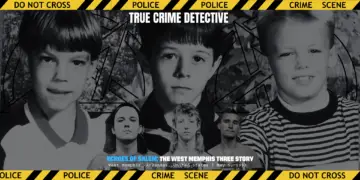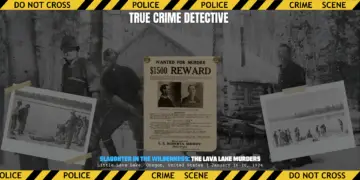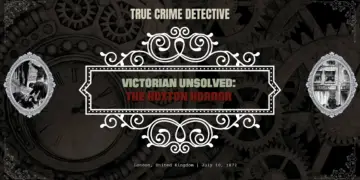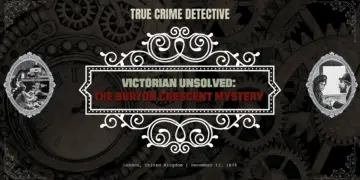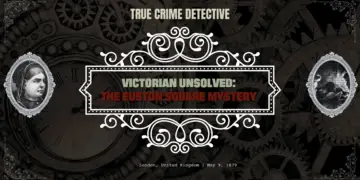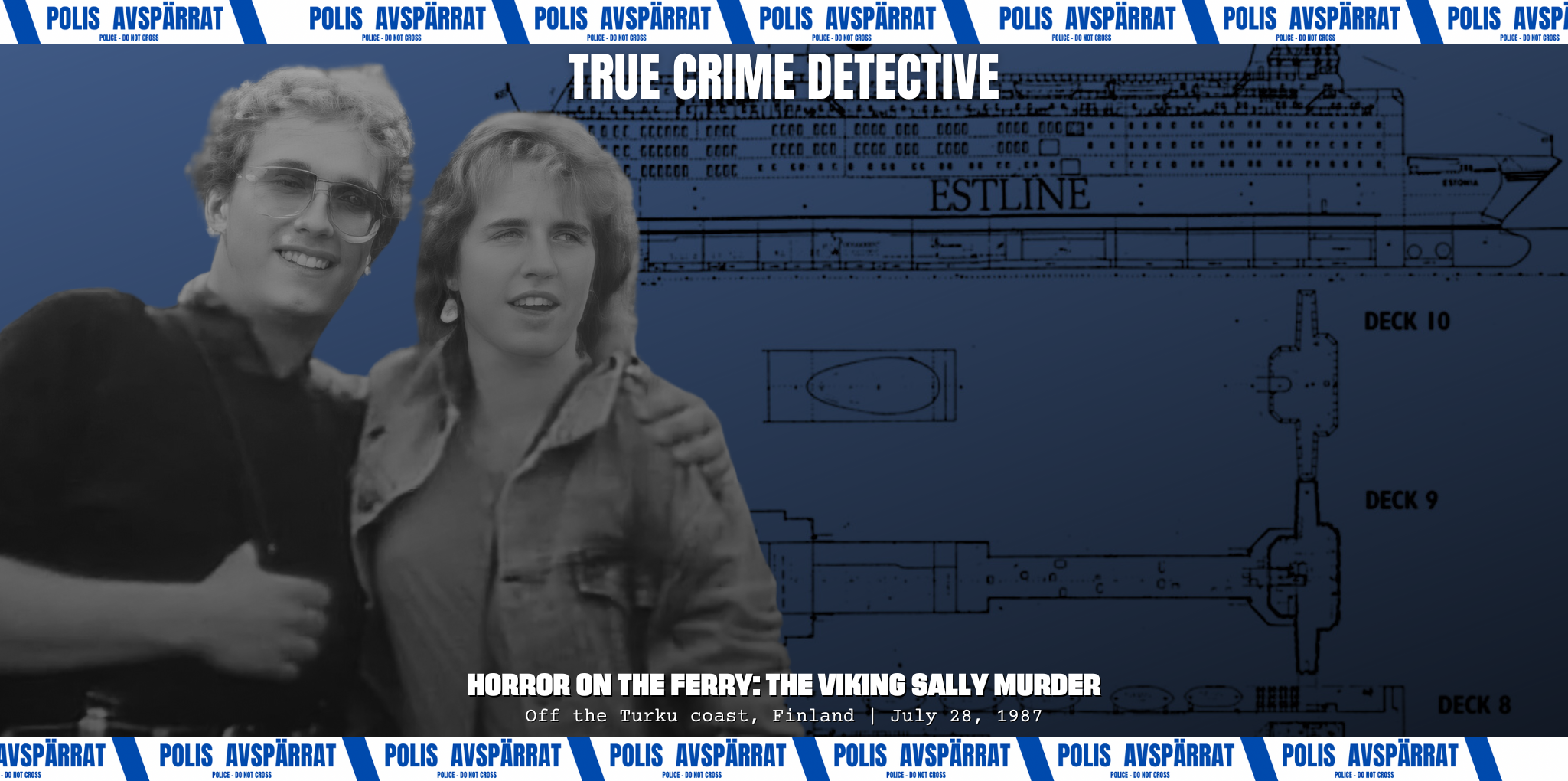
Horror on the Ferry: The Viking Sally Murder
In 1987, a student holiday turned into carnage as Klaus Schelkle was brutally murdered at sea, with his girlfriend Bettina Taxis left fighting for her life. The case is unsolved.
Travelling by sea can be an amazing adventure. It’s a unique experience that combines feelings of peace with excitement as you navigate vast open waters. The allure of exploring new places, feeling the salty breeze on your face, and meeting a diverse group of people on board creates an atmosphere full of anticipation and friendship. However, there’s a disturbing truth beneath this calm: you are trapped with nowhere to run.
The idea of being trapped on board a ship with a psychopath has fascinated many, being a trope in numerous thriller and horror films. However, events on board the MS Viking Sally in 1987 show that there is some truth behind this fiction.
Some may say that the ship was cursed, the scene of two murders, a maiming and finally, one of the biggest tragedies of the 20th century. However, this passes responsibility for the horrifying events to come from the realm of men into the world of the supernatural when the truth is that the horror on board the Viking Sally was solely the work of a man-made evil. It is a tale that will forever make you question the true nature of those you share your travels with.
The Trip of a Lifetime
20-year-old Klaus Schelkle and his 22-year-old girlfriend Bettina Taxis likely expected memories that would last a lifetime. The West German couple had decided to tour the Nordic countries alongside their fellow student and friend Thomas Schmid. Away from home, the couple could take in Scandinavia’s beauty before travelling to Lapland in Finland, one of the world’s greatest natural beauty locations. The couple had been together six months, and with time alone and romance in the air, Klaus and Bettina would be in for an unforgettable experience. Klaus and Thomas, meanwhile, had been firm friends for five years, sharing a love of cars.

The trio planned to travel from West Germany to Sweden via rail, headed to Stockholm’s capital. From there, there would move onto Turku in Finland and then to Lapland before returning along the Norwegian coastline. After starting from Stuttgart on July 23, 1987, they travelled through Denmark and eventually made it to Sweden. They stayed for a few days in Stockholm, sending postcards and correspondence back home, letting family and friends know they were enjoying their trip. However, the core of their journey truly began on July 27, when at 10pm, they boarded the MS Viking Sally, part of the Viking Line fleet that sailed between Sweden, Finland and Åland, with the trio intending to cross the Gulf of Bothnia and dock in Turku at 8am the next morning.
The Viking Sally was a large but troubled ship. With a capacity for 2000 passengers and 400 vehicles, she was launched in 1980 and served the Turku, Mariehamn and Stockholm route. The ship had run aground in 1984, and in 1986 a passenger had been murdered, with the culprit being described as the most dangerous criminal in Finland.

It had been on July 10, 1986, that Reijo Hammar went to businessman Antti Eljaala’s cabin and stole money from his wallet. Eljaala tried to raise the alarm and was stabbed five times in the throat and strangled with the assistance of an accomplice. Hammar was arrested and found guilty of the killing, being in prison when Schelkle, Taxis and Schmid boarded the Viking Sally, meaning he plays no part in our narrative. Yet, the killing would be just one of several tragedies associated with the vessel, concluding in one of the biggest disasters of the 20th century.
It’s unlikely that our trio had even heard of Antti Eljaala’s murder, and even if they had, they would have had little choice but to continue aboard the Viking Sally. Once on board, everything was as Klaus, Bettina, and Thomas will have expected. They made a few small purchases at the shop and travelled the decks to become acquainted with the ship, no doubt searching for a place to later bunk down.

Despite saving up all year, being students, they were still short of cash and would be forced to sleep in a public area rather than have cabins. Still, they were determined to make the most of it and became quickly acquainted with their diverse fellow travellers. The atmosphere was social and convivial, with everyone except Schmid being outgoing.
One of the travellers they met was a British man, known later in the press by the alias Patrick Haley. Haley was 26-years-old and, unknown to those on board the Viking Sally, was a troubled man. His studies had failed, and a bad breakup with his former fiancée had sent him spiralling into drugs. Looking for a fresh start, Haley had abandoned London to work on a Kibbutz in Israel, a form of a farming collective that was a frequent site for international visitors seeking to find themselves. While there, Haley met a Finnish student, Maija, and the two decided to travel to her home in Lapland. With no money to their name, the pair had travelled through various countries, working odd jobs and backpacking before ending up in Stockholm and ready to make the final leg of their journey into Finland.
However, just as the end was in sight and the duo arrived in Helsinki, Haley was denied entry and sent back to Sweden. Penniless and shabby, he had seemingly been seen as something of an undesirable. Haley was now trapped in Sweden, and not wanting to be apart, Maija sent join enough money to travel back to Finland, this time intending to enter Turku. With that intention in mind, Haley had boarded the Viking Sally.
Alongside Haley, our German travellers met businessman Tauno, who delivered car parts. Tauno established an instant rapport with Klaus, who was studying automotive technology. The two exchanged addresses, with Bettina nicknaming Tauno the “fun Finn.” Moving along by the helicopter pad, our trio met Sami, Pentti and Ville from Finland, who had enjoyed a boy’s day out in Stockholm. They had spent all their money on getting drunk and had a few bottles left. The passengers were from at least nine different nations, with everybody from war veterans to a group of scouts filling the decks and cabins.
Horror at Sea
It was around 1am on Tuesday, July 28, and everyone was either already asleep or making preparations. Thomas was asleep, and Klaus and Bettina returned to get their sleeping bags. Thomas had stayed inside as he didn’t want to get cold, and it also seems likely that the couple wanted some privacy for their sleeping spot, and they headed to the 9th Deck at the stern of the vessel. The deck was open to the air, but the two had found a secluded spot near the helipad that was dimly lit but sheltered by a plexiglass windshield. Meanwhile, elsewhere on the ship, Patrick Haley had hooked up with Sami, Pentti, Ville and a few others and, having some extra money from what Maija had sent him, treated everyone to food and beer. Others who were still awake said that the group was boisterous before they eventually broke up and went to sleep across the ship.
What happened over the next hours is unclear, but before 3:45am, one of the scouts, 18-year-old Thomas Nielsen, woke early in his cabin and decided to walk on deck. Nielsen had already been out on deck a few hours previously and seen Klaus and Bettina, with everything having been fine when he’d been there. He decided to walk the same route, and approaching Deck 9, Nielsen again discovered Klaus and Bettina surrounded by three other concerned scouts from a separate Swedish group, all of the different groups being on their way to a jamboree gathering in Finland. Nielsen initially thought the two were drunk while struggling to stand. However, it soon became apparent they were both suffering from serious head injuries, with the deck soaked in blood.


“I was walking on the helicopter deck and suddenly saw three other boys by the sleeping bags. At the same time, I noticed that something was crooked. When I got closer, I noticed that there was blood everywhere, and the young people lying in the sleeping bags were covered in blood,” Nielsen would later say in an interview. “The boy tried to get up, by then he was outside the sleeping bag, but he couldn’t get up. The girl was inside the sleeping bag and tried to say something. Next to them were empty and full beer bottles.”
Shocked, Nielsen made to attempt first aid as the others ran to raise the alarm, but it was obvious that both were beyond the basic medical training of the scouts. Ten minutes later, the ship’s captain, nurse and security headed to Deck 9. The couple had been the victims of a ferocious attack and received severe blows to the head from an unknown weapon. Both needed urgent medical attention.
“The face had not been hit or kicked, and in my opinion, the abuser had not used a knife either,” Nielsen revealed. “Their faces were like slush as if they had been beaten with something like a hammer. No wounds were visible on their bodies.”

Both Klaus and Bettina were moved indoors, with Bettina seemingly in much worse condition than her boyfriend, having to be carried from the scene by Nielsen while Klaus could walk under his own power with the nurse’s help. The Finnish Coast Guard dispatched a helicopter in all haste, and both Klaus and Bettina arrived at Turku University Hospital at 5:48am. However, it would be too late for Klaus Schelkle, who, despite seeming to have been less injured than Bettina, died during the flight, being pronounced dead on arrival.
Given the Viking Sally’s passage and the timing of the killing, the crime might have occurred either in Åland or Finland. Åland is a sparsely populated autonomous archipelago of islands off the southern Finnish coast. Given the severity of the crime, Finnish authorities believed that Åland wouldn’t have the resources to investigate and quickly declared the murder and attempted murder to have taken place in Finnish waters under the jurisdiction of Turku police and the National Bureau of Investigation (NBI).
Finnish police were quick to work, and detectives and crime scene investigators led by Chief Constable Veikko Laaksonen were dispatched immediately, arriving on the Viking Sally on the same helicopter that had transported Klaus and Bettina to the hospital. It was 6:30am, and the ship was still at sea, a little under two hours away from docking in Turku. Police used these hours wisely, and luckily the security officer, Raimo Vahlsten, had the sense to make sure the crime scene was secure and untouched. Police secured fibres, fingerprints, shoe prints and a bloody palm print from the crime scene, yet there was no immediate clue as to the perpetrator, and police ensured that the ship was surrounded when it arrived in Turku. They intended to lock everyone on board down and patrol the sea nearby to check for anyone attempting to dispose of evidence overboard. However, these plans to record and interview everyone on board soon became a logistical nightmare, with around 1400 passengers and few facilities to keep them confined to the ship. As such, police were forced to narrow their search, deciding to let the elderly, families and children go.
Despite their wide search parameter, police quickly concluded that Klaus and Bettina had been acquainted with the killer. They immediately detained Schmid, Haley and the drunken youths. Haley was particularly interesting as he had been found wearing clothes stained with blood that morning. He claimed that the blood was his own and he’d had a nosebleed, yet the police found the story somewhat convenient and repeatedly interviewed him while they awaited forensic test results. The analysis found that the blood was almost certainly his own, though this wasn’t 100% conclusive and didn’t rule out the possibility he had been injured in a struggle. Schmid, meanwhile, was allowed to go when it became clear he had nothing to do with the attack, knowing nothing after he was woken by Klaus and Bettina retrieving their sleeping bags.
“When the police came to wake me up, I had no idea what had happened,” Schmid would later say. “We were sitting up on the deck, but the air was cold, and I went inside to look for a place to sleep… After half an hour, I woke up to Klaus and Bettina coming to get their sleeping bags. They were in a great mood and said they had met a nice Finn. Then they faded away. It was around midnight then.”
Unfortunately for the police, their investigation was hampered by the situation of the killing. It was complex enough with 1400 people on board, a ship that needed people disembarking, and a dock teeming with life and heading to multiple countries. But the crime scene by the helipad was remote, with no CCTV footage and police unable to do a full forensic search of the ship. What forensic evidence they collected provided little information. Fibres found at the scene revealed little and blood tests showed nothing unexpected, with only Klaus and Bettina seemingly having bled. There were no unusual shoe prints, and the bloody palm print left on the wall couldn’t be traced to anyone that was analysed.
Meanwhile, Bettina Taxis recovered well from the attack. However, she is said to still live with serious life-long injuries, including an amputated finger, likely from an attempt to defend herself. Although police have never publicly revealed her full statements, she had no memory of anything between getting into the sleeping bag and ten days later. All she remembered was Klaus listening to music through earphones for a short time before he took off his glasses and placed them inside his shoe for safety. The two then went to sleep. Investigators did what they could, tracing and interviewing as many passengers as possible and travelling on the ship several times to try and find fresh clues but with little result.
In August, a fisherman discovered a bag of clothes on the tiny uninhabited island of Lilla Björnholm. The island was just 200m from the shipping lane. The fisherman left the bag where it was for a whole year until 1988 when they realised it was still there. The bag contained several items: a glove with an “HK” monogram, shoes and a jumper. Police believed that forensic evidence in the bag linked it to the Viking Sally, though none of the clothes has been said to show traces of blood.

Whether finding the bag sooner may have helped is unknown, and fresher memories may have helped identify an owner, but in any case, the investigation was, by this point, completely stalled.
Police interviewed over 1000 people, with more than 250 samples sent to NBI labs for testing. There were thousands of pages of documents, and police worked across nine nations to trace those who’d been on board the Viking Sally. The amount of data was overwhelming.
From Horror to Tragedy
Late in 1987, the MS Viking Sally was sold to Silja Line and put on a new route. However, in 1990 she was completely repainted and renamed Silja Star, returning to the Turku–Mariehamn–Stockholm route. The following spring, she was transferred to the Wasa Line and renamed again, this time to Wasa King, before being sold again in 1993 to Estline, a Swedish-Estonian shipping company. Upon its sale, the ship became the largest Estonian-owned vessel of the era, with many taking pride in her as a representation of the country’s new independence from the Soviet Union. As such, there was only one name for her — the MS Estonia.
On Wednesday, September 27, 1994, the former Viking Sally departed for Stockholm with 989 passengers on board, mostly Swedish. Poor cargo distribution saw the ship listing slightly to starboard, and the weather was rough. In the early hours of September 28, waves began hitting the bow doors close to the Turku archipelago, where Klaus Schelkle had been murdered all those years before. The metallic banging was heard all over the ship as the locks on the bow doors failed, and the door and visor of Estonia became separated, ripping open the loading ramp to the sea. The ship subsequently listed even more to starboard, and the vehicle deck flooded with water, beginning to sink shortly after 1am.
The flooding was rapid, with water bursting out of the vehicle deck. Hundreds of people in cabins could not ascend to the decks above as they drowned trapped below. Water flowed through windows, ceiling panels, stairwells and down corridors. A mayday was called at 1:22am, and by 1:50am, Estonia had vanished from radars. The sinking took less than an hour. Of the 989 people on board, 852 died, making the sinking of the MS Estonia, the former Viking Sally, one of the worst European maritime disasters in peacetime, topped only by the Titanic and Empress of Ireland.
A New Suspect Arises
With the ship gone and the investigation into the murder of Klaus Schelkle closed in the 1990s, it seemed like the MS Viking Sally killing was destined to become an eternal cold case. After all, police seemingly had no forensic evidence, witnesses, or motive, with the murder almost being a perfect crime. However, in 2019, police revealed that they had a new prime suspect in the case, refusing to reveal anything more than the suspect was a male, was still alive and was believed to have acted alone in the attack and murder. They also seemingly exonerated longtime suspects like Haley by stating that they didn’t believe the suspect had been known to Klaus or Bettina before the attack.
So sure were Turku police that they had their man that in September of 2020, they announced the case solved and passed what they had onto prosecutors who, two months later, in December, indicted a 51-year-old Danish man, Herman Himle, on a murder charge. Back in 1987, Himle had been known by his original birth name — Thomas Nielsen, the 18-year-old Boy Scout who had found the injured Klaus and Bettina.
Himle had been questioned as part of the original inquiry, with his scout leader reporting that he “enjoyed being in the spotlight and didn’t seem sad or troubled at all by the things he must have experienced on the ship.” The scout leader also saw him covered in blood but assumed it was from helping Klaus and Bettina and even helped him find fresh clothes and clean the bloody ones afterwards.
Following the 1987 murder, Himle had given a detailed interview to Seura Magazine, quoted in this article, where he described the events of the morning in question in extreme detail, even stating that the murder weapon had been a hammer rather than a knife. How obvious this would have been to somebody merely discovering the victims on the darkened Deck 9 is debatable. From then, Himle had been in and out of prison all his life, serving time for robberies, theft, weapons offences and threats of violence. During the intervening years, Himle would use the killing of Klaus Schelkle for his own ends, bragging about getting away with murder or using it to threaten people. He even confessed to the leader of a prison choir, with the choirmaster later telling the press that the murder was a “great sadness” for Himle and that she believed the suspect was a “real psychopath.”

In 2015, Himle had sent multiple text messages to his ex-wife, threatening her and admitting the attack. Some quotes attributed to him include saying, “I am a murderer, and I can prove it, but then I would go to prison for a long time”, and “You’re right that I’m evil; I’ve killed two people.”
“I’ve been interrogated, and they can’t do anything about that ship thing,” one of the messages from Himle read. “I remember the ship like it was yesterday. Yes, I am a murderer, and I can prove it, but then I will go to jail for a long time, and I will not go to jail because then you will escape my revenge which will come when you least expect it.”
Now with the police involved, he is said to have confessed “off the record” in 2016 that he carried out the killing. Visited in a Danish prison by police constables Mika Paaer and Sirpa Saarinen from Finland, he indicated that he was responsible for the killing, with Paaer quickly winning his trust. During a further visit the next day, Himle explained how he “could have done it” and refused to have legal representation present for the interviews. Once the formal questioning was concluded, Himle suggested they visit the prison yard, where he would give even more details. Himle confessed to Paaer there, with the constable not recording the conversation.
Himle provided many details, including revealing that the weapon used was a slag hammer. A slag hammer is used in wielding to scrape away slag that builds up during welding. It is heavy-duty and has a sharper edge and a blunt one. Forensic indications were that it would have fit the wounds suffered by the two victims, and Himle showed knowledge of features that had never been revealed to the public. Himle claims to have disposed of the weapon overboard just before the Swedish scouts arrived, having been lurking nearby the whole time.

During his interviews, Himle was vague about his motives for the attack, suggesting that robbery was at the bottom of it, and that’s the real reason he’d been prowling the ship at such an early hour. He suggested that his mental state had been impaired and that something that had happened back at his home in Denmark just before the trip had pushed him into a corner and driven him to the point of an emotional explosion. Equally, he was angry that he hadn’t received any money for the trip from back home, nor any new equipment, and decided to both take his anger out on somebody and rob them simultaneously. Once done, the killer revelled in the hero narrative he built, inserting himself into the rescue efforts and investigation, as many killers have done before. Everything seemingly fitted together.
“Himle said that he would like to tell [Bettina Taxis] that she no longer has to be afraid. He said that the woman can be told that the police talked to the right man today,” police later said. “He said that he dared to say this because the police would never be able to prove him as the perpetrator. He didn’t want to directly admit that he killed Klaus Schelkle and that he tried to kill Bettina Taxis because he considered that his statement now was enough to tell who the perpetrator was.”
After slow progress, Finnish prosecutors decided that Himle needed to be interviewed again in 2019, being dissatisfied that the suspect had rejected legal assistance during his original interview and that the records of the conversations were alarmingly incomplete. However, when they tried to interview Himle again, he denied everything. Despite this, they pushed ahead.
Herman Himle was brought to trial in May 2021, and nothing went right for the prosecution. Himle had recanted his confession, which had been made without a lawyer present and without independent witnesses, making it inadmissible in court. The questions had been leading, and the interview was conducted in English, which wasn’t Himle’s native language. Another key witness, Herman’s ex-wife, also refused to testify, citing mental health reasons, although previous police interviews revealed she lived in absolute fear of her one-time husband. Other witnesses, such as the scout leader that saw Himle covered in blood, had died since the original 1987 attack.
“It is such a bad violation of rights that we cannot accept that such a thing is used here,” lawyer Martina Kronström told Aamulehti. “He didn’t have an assistant, he was in such a state that it would have been impossible to have a conversation without an assistant, and besides that, he has been consulted in a language he doesn’t know.”
In his defence, Himle claimed he was a fantasist who had nothing to do with the murder. They said that he simply tried to use the killing to advance his notoriety in the criminal underworld or scare people, including his ex-wife. The judge ruled that the prosecution had failed to find a motive for the attack or prove that Herman was the only one on board capable of or with the opportunity to commit the crime. Herman Himle was acquitted of all charges in June. However, if anyone thought he’d put his life of crime behind him, they’d be mistaken, and in March 2023, Himle was arrested again, this time for arson.

While Herman Himle may seem like the best chance of solving the case, we must remember that justice requires evidence of guilt beyond all reasonable doubt. While Himle being covered in blood would seem to be evidence, the counterpoint that it could have come from helping carry Klaus and Bettina could be valid. While his repeated confessions would seem to prove the case, thousands of fantasists have claimed responsibility for notorious killings over the years, and Himle may be another. While he seemingly had knowledge of the murder weapon, whether it truly was a welding hammer is likely never to be known.
And that’s where we come to motive. Himle stated in his interviews that he was lucky that the other Swedish scouts had arrived on the scene, fearing that he would have otherwise been caught in possession of the victims’ property. Yet, police never believed robbery was the motive, and there were no reports of missing equipment. Indeed, Klaus and Bettina had not only left their property except a handbag and Walkman with Schmid, but police had photographed said property and nothing was missing. Equally, Himle had confessed to many people since 1987 and told others that his motive had been because Klaus and Bettina had annoyed him.
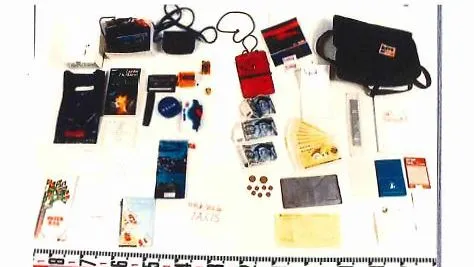
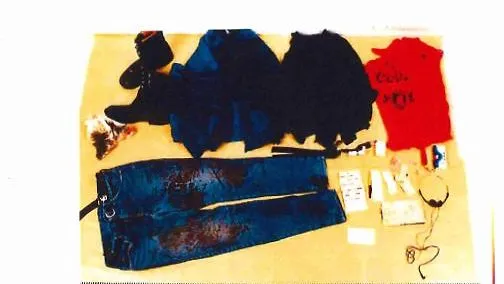
That wasn’t the end of the defence, however. At trial, they argued that these scouts would have noticed if Himle had been covered in blood, while the prosecution pointed out that he was wearing dark clothing and the area was also dimly lit. The defence also raised the possibility of other culprits, including a fabric worker who committed suicide in 1988 and the man who had worn the clothes discovered on Lilla Björnholm in August of 1987.
Although Himle had been in prison for many years and clearly a highly unpleasant man who threatened violence, he’d never been convicted of another violent offence. The attack on Klaus Schelkle and Bettina Taxis was ferocious, with the killer standing over the pair and remorselessly raining down blows onto their skulls. Was such an attack indicative of a first violent offence? And would such a killer never strike again? It seems unlikely, even though, by his own admission, Himle was under mental strain and suggestive that he may have been in the throws of temporary psychosis.

Whatever the true motive, the attack on Klaus Schelkle and Bettina Taxis was brutal, merciless and psychotic. What should have been a trip full of youthful wonder, energy, friendship, and romance ended in blood and carnage. Whether that was the work of Herman Himle is debatable, with prosecution failures and lack of evidence leading to his acquittal. As highlighted at his trial, there were other suspects, and there’s the possibility that Himle is indeed telling the truth, with his own life of crime and state of mind perhaps caused by the horrors he’d seen aboard the Viking Sally.
The murder of Klaus Schelkle and the subsequent trial of Herman Himle show how difficult justice can sometimes be. While it may seem obvious and perhaps even likely that Himle was guilty, there simply wasn’t the evidence to prove that, and there is an unfortunate history of condemning individuals to life sentences and even death when a case has seemed “obvious” to the general public. It’s important to remember that the justice system’s goal is to provide a fair and impartial resolution to each case based on the available evidence and legal principles. While it can be disheartening when justice appears elusive, it highlights the need for thorough investigations, strong evidence, and adherence to legal procedures to ensure the integrity of the judicial process.
In the end, the possibility of justice for Klaus and Bettina was snatched away just as it appeared the final ghost of the Viking Sally may be laid to rest. And while, like those in the courtroom, we can’t say anything beyond a reasonable doubt, perhaps Herman Himle’s words give the best answer to the case, defying its status as “unsolved.” Speaking with police, the suspect once said that “every human being has a demon or a devil that needs to be let out.” It seems likely that that demon stalked Deck 9 of the Viking Sally one tragic summer’s morning in 1987.
